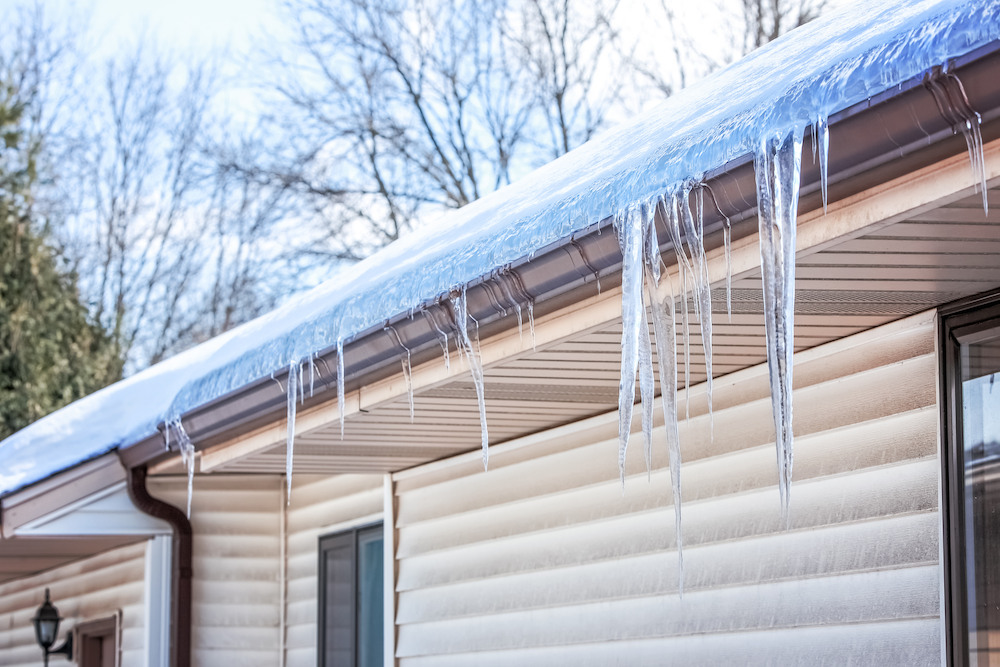Preparing your Gutters and Roof for Winter

Winter weather can be punishing on any roof, but if your gutters are not properly prepared, your roof could be in serious trouble. By following these steps, you can give your roof its best shot at weathering whatever winter has in store with the minimal likely chance of damage.
1. CLEAN OUT GUTTER
Gutters are crucial in safely redirecting water away from your roof, siding and foundation, but debris and other refuse can built up and clog them over time. If left obstructed, rain water or melted snow can pool and seep under your roof shingles or lead to the creation of ice dams. Because of this, it is important to clean your gutters at least once a year.
For best results you may wish to wait until the majority of leaves have fallen off the nearby trees, though we would advise not waiting if there are already signs of pre-existing blockage. If you own an extension ladder, you can easily clean gutters yourself. We recommend the use of a pair of waterproof work glove as the debris may be damp or unpleasant to handle with bare hands. While clearing the gutters, preform a visual inspection of the roof and gutter system to check for signs of wear. If you notice any damage, get it repaired as soon as possible to avoid a leaky roof or miss your weather window.
If you don’t want the hassle of cleaning out gutters every fall, you may wish to consider installing gutter guards. A properly installed guard system should keep the majority of buildup out of the drainage system.
2. CONSIDER INSTALLING ROOF CABLES
Ice dams are ridges of ice that form at the edge of a roof from the repeated freezing and thawing of improperly drained water. These ice formations can cause serious damage to your home, including tearing off gutters and shingles, leaks, mold, mildew and more. Ice dams can also prove dangerous if they dislodge from the roof suddenly and fall to the ground.
Roof cables are essentially heated wires installed in a zigzag pattern on the edge of a roof. They heat up to melt the snow immediately around them, providing a path for water to flow into your gutters. A properly installed cable system could be the difference between a clear roof and a sagging one.
3. CLEAN OVERHANGING BRANCHES
Check for dead limbs or tree branches that hang over your roof. Branches can be snapped off during winter storms and some may be brought down due to heavy snow collection. A large branch coming down on your roof could be devastating, but even smaller ones can cause damage to shingles or gutters. Consider trimming back any branches that might be at risk of hitting your roof if they fall.
4. CHECK THE INSULATION IN YOUR ATTIC
Having proper insulation won’t just save you money on your heating costs, It also can help protect your roof as well. Too much heat escaping from the attic thru gaps or thin spots in insulation can result in the uneven melting of roof snow, leading to ice dams. A full 10 to 14 inch layer of insulation in your roof can stop heat from escaping in this manner. You may also need to seal any air flow leaks from your living spaces. Plumbing pipes, light fixtures, chimneys and sewer vent pipes are common sources of heat loss. Plug the gaps with a weather-resistant sealant foam or tape that expands to fill gaps up to ¼-inch wide. Additional heat can also come from bathroom or dryer vents. If either are vented into your attic, you should reroute them through an exterior wall. It would also be a good idea to check the weatherstripping on your attic windows and access doors, and update or repair them accordingly.
5. KEEP PESTS OUT
Don’t let pests become unwelcome guests this Winter. Check along the roofline for any holes or gaps that critters can crawl in through and seal them up tight. Consult with an ACE professional if you have questions concerning what materials and process would work best for this. You may also wish to purchase traps or strips for the inside of your attic, depending on the types of pests common in your region.





